
 The newsletter of NASA's Radio JOVE Project
The newsletter of NASA's Radio JOVE Project"Solar and Planetary Radio Astronomy for Schools"

 The newsletter of NASA's Radio JOVE Project
The newsletter of NASA's Radio JOVE Project
Good news! The Juno spacecraft is rapidly approaching Jupiter for an encounter on July 4, 2016, and for the 20 months to follow. Juno will provide an unprecedented view of Jupiter’s atmosphere, magnetosphere, auroras, and gravity field. See the December 2015 Bulletin article for more information about the spacecraft and its instruments (http://radiojove.gsfc.nasa.gov/library/newsletters/2015Dec/index.html#1). In an effort to support the mission, many professional ground-based radio observatories will be observing Jupiter to supplement the data from the Juno Radio/Plasma Waves instrument.
Amateur optical astronomers are participating in a visual campaign to help scientists plan for the future of the mission (https://www.missionjuno.swri.edu/junocam). In a similar way for the radio community, we hope that the Juno mission will inspire Radio Jove participants to make radio observations of Jupiter this year and in 2017. So put your Radio Jove receiver and antenna into operation again, or ready your new Radio Jove telescope, and make observations and join the effort. The Radio Jove community can participate by observing Jupiter during the upcoming months as Juno begins its 20-month mission. As always, we encourage you to upload your data to the Radio Jove Archive (http://radiojove.org/archive.html).
Jupiter is rapidly approaching conjunction with the Sun on 26 September, 2016. Therefore many observations of Jupiter will occur in the daytime. If your site is relatively free from radio frequency interference (RFI), and Jupiter emits strongly, you may be able to record Jupiter during the daytime. Recognize that the Earth’s ionosphere is more opaque to lower frequencies during the daytime, but detecting strong emission above 15 MHz is still possible. To help you plan observations for the next few months, the table below shows Jupiter high probability radio event predictions for the geographic center of the continental U.S. (Lat 39° 50’, Long 98° 30’ W) for July – Sept, 2016. The Hour Angle represents the position of Jupiter in the sky relative to transit (e.g., at 0.0 hour angle the object crosses the observer’s N-S meridian line, and is at its highest elevation for that day). The Comments let the observer know in what part of Jupiter’s high probability region will the observation take place on the Io-Phase – CML plane. See the previous Bulletin article for more information on the Jupiter probability map (http://radiojove.gsfc.nasa.gov/library/newsletters/2012Jun/index.html#7). Better yet, use the Radio Jupiter Pro software (http://radiosky.com/rjpro3ishere.html) to provide more accurate dates and times for your location. Safety Warning: Remember to disconnect your Jove receiver from the antenna if there is any lightning in your area.
Be on the lookout for announcements regarding coordinated observations via the Radio Jove email distribution list. This is a great way to get involved with Radio Jove, to get help and ask questions, to confirm your observations, and perhaps to help the professionals with your data.Thank you for your observations!
| 2016 UT Date | Begin UT | End UT | Jupiter Storm | Hour Angle | Comments |
|---|---|---|---|---|---|
| 4-Jul | 19:20 | 22:44 | Io-A,Io-C | -3.4 to 0.0 | good pass for Io-A source |
| 5-6 Jul | 22:05 | 12:30 | Io-B/D | -0.6 to 1.8 | high pass for Io-B source |
| 11-12 Jul | 20:06 | 0:33 | Io-A,Io-C | -2.2 to 2.3 | good pass for Io-C source |
| 12-13 Jul | 22:51 | 2:00 | Io-B/D | 0.6 to 3.7 | good pass |
| 18-19 Jul | 20:52 | 1:19 | Io-A,Io-C | -1.0 to 3.4 | low pass |
| 20 Jul | 0:25 | 3:00 | Io-B/D | 2.6 to 4.9 | good pass |
| 25-26 Jul | 22:06 | 2:05 | Io-A,Io-C | 0.6 to 4.6 | low pass |
| 27-28 Jul | 23:16 | 0:56 | Io-A | 1.9 to 3.5 | high pass |
| 30 Jul | 17:44 | 21:00 | Io-B/D | -3.5 to -2.1 | high pass |
| 2016 UT Date | Begin UT | End UT | Jupiter Storm | Hour Angle | Comments |
| 4-Aug | 0:03 | 2:33 | Io-A | 3.3 to 5.6 | high pass |
| 5-Aug | 15:45 | 19:38 | Io-A,Io-C | -5.2 to -1.3 | good pass |
| 6-Aug | 18:30 | 21:30 | Io-B/D | -2.3 to 0.3 | good pass |
| 12-Aug | 16:31 | 21:30 | Io-A,Io-C | -3.9 to 0.5 | good pass Io-C |
| 13-Aug | 19:24 | 22:30 | Io-B/D | -1.1 to 2.1 | good pass |
| 19-Aug | 17:17 | 21:44 | Io-A,Io-C | -2.9 to 1.6 | low pass |
| 20-Aug | 21:24 | 23:06 | Io-B | 0.8 to 3.0 | low pass |
| 26-Aug | 19:05 | 20:34 | Io-A | -0.7 to 0.8 | low pass |
| 28-Aug | 19:42 | 21:56 | Io-A | 0.0 to 2.2 | high pass |
| 2016 UT Date | Begin UT | End UT | Jupiter Storm | Hour Angle | Comments |
| 4-Sep | 20:28 | 23:00 | Io-A | 1.2 to 3.7 | Io-A center pass |
| 7-Sep | 14:56 | 18:00 | Io-B/Io-D | -4.3 to -1.2 | near center pass |
| 11-12 Sep | 21:00 | 0:30 | Io-A/Io-C | 2.3 to 5.3 | good Io-A pass |
| 13-Sep | 15:00 | 17:25 | Io-A/Io-C | -5.9 to -1.4 | low pass Io-C |
| 14-Sep | 16:30 | 18:45 | Io-B/Io-D | -2.3 to 0.0 | good Io-B pass |
| 18-19 Sep | 22:00 | 0:31 | Io-A | 3.4 to 6.0 | low pass |
| 21-Sep | 18:31 | 19:31 | Io-B | 0.1 to 1.1 | low pass |
| 22-Sep | 15:21 | 16:58 | Io-A | -3.0 to -1.4 | high pass |
The Radio Jove community is deeply saddened by the loss of one of our early contributors to the Radio Jove project, Ruggero Ulivastro of Nice, France. Soon after Radio Jove began in 1999, Ruggero joined our group and helped us with some excellent observations from his Radio Jove dipoles and Yagi and Moxon antennas set in southern France at Berthemont-les-Bains in the Alpes Maritimes (Figure 1).
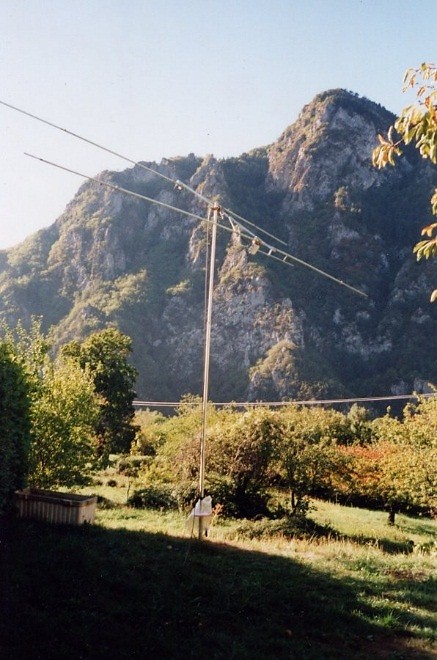
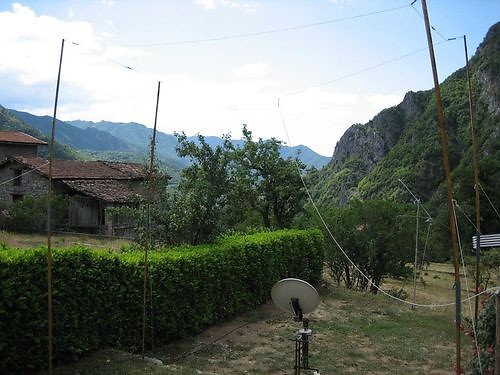
Little did we know that Ruggero had been observing Jupiter and solar events sporadically since 1979. His last observation was in 2009 (Figure 2). Not only was he a dedicated and excellent observer, he also wrote some software to calculate the flux density of the Sun or Jovian bursts, and to calculate the impedance of a transmission line. He also prepared Jupiter prediction tables for central Europe for many years during the early days of Radio Jove, from 2000-2006.
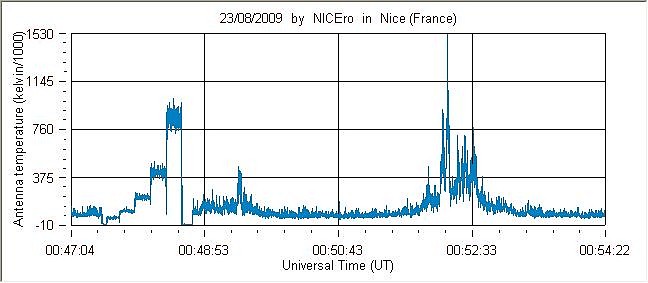
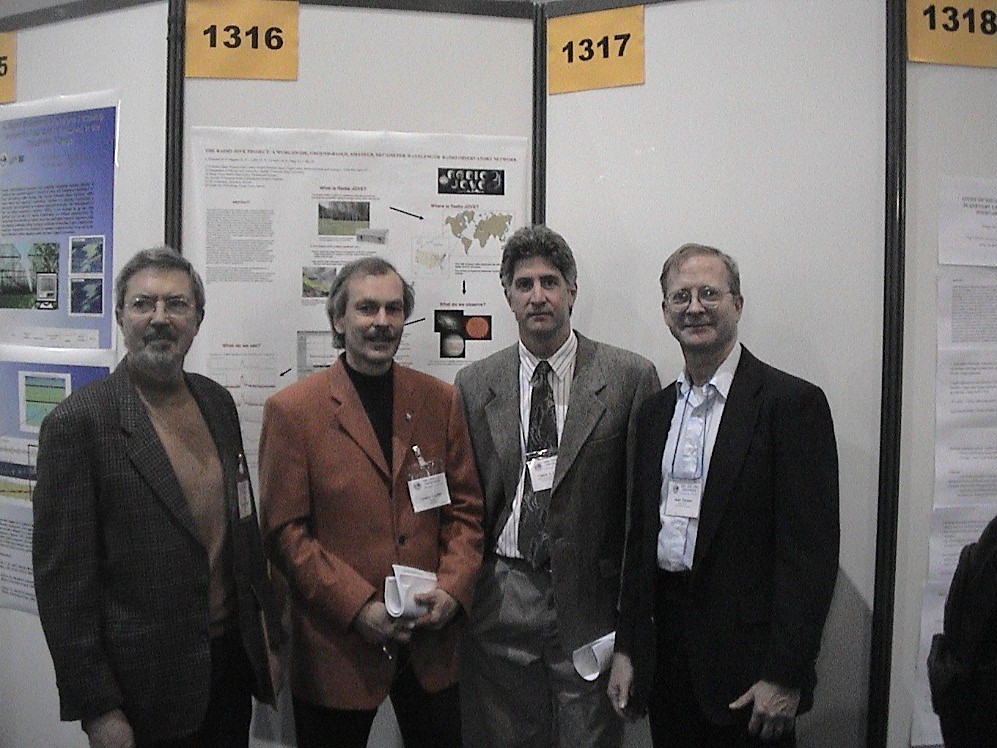
Jim Thieman and I had the pleasure of meeting Ruggero at a conference in Nice, France in 2003 (Figure 3). This photo was taken in front of the Radio Jove poster at the joint American Geophysical Union – European Geophysical Society meeting. He was a very fine gentleman and a great friend to the Radio Jove community. Au revoir cher ami.
Last semester, which was the spring semester of my Sophomore year at Wheaton College in Norton Massachusetts, I took a class called Frontiers of Astronomy. Part of this class' final grade required completing and presenting an independent project of some sort. At first I had no idea what I wanted to do for the project. Upon discussing with my professor, Dipankar Maitra, I had mentioned my interest in circuitry. He then told me that he had the perfect project for me to complete, and presented me with the Radio Jove kit.
Having been the Circuitry Lab Assistant for Wheaton's circuits class, I went into this project thinking, “How hard could this be? Just soldering some components into a board shouldn't prove to be too much of a hassle.” Needless to say, I far underestimated the difficulty I would have with the receiver. For those who have not had much soldering experience, take these words of caution: the more pins a component has, the longer it will take to unsolder it if you make a mistake. This became clear to me when I soldered the oscillator in the wrong direction, and also when I had to remove the variable inductor which I had stripped while tuning it. The inductor is another difficulty I experienced in which I broke a part. Thankfully Chuck Higgins was kind enough to replace the parts for me that were broken. If it weren't for Chuck's help, I probably would never have finished the telescope.
Funny enough, the biggest difficulty I experienced with building the receiver did not arise until after I had finished the circuit. The most difficult part was screwing together the housing structure. For the life of me, I just couldn't get the screws to screw in straight, leaving the panels to not line up correctly. Eventually, I got it as best as I could and it was time to move onto the antenna.
[Editor's Note: The screws in the enclosure can be threaded into the aluminum channel pieces to precut threads before actually assembling the enclosure - thus ensuring that the screws will run straight and true in the pre-cut threads.]
Although I was only planning on using a single dipole for my project, I prepared a second dipole for future use. It was certainly a trial to cut the wires on my own because they kept curling up. I ended up having to use a heavy portable clamp to hold down one end of the wires while I measured out and cut the other end. At one point I misread the directions and cut the wrong length of one of the coaxial cables, so then I had to go to Radio Shack and buy a new one.
I finally finished the antenna with just a week to spare before the deadline. Dipankar and I decided the best place to set up the array was in the field next to the old observatory. Upon setting up the array, we did an audio test with headphones. We were picking up static which was a good sign. However we then suddenly started to pick up a Spanish radio talk show. I adjusted the frequency a hair until it dissipated.
For my project, and to prove that the telescope actually worked, I planned to take three data sets of five observations two minutes each, using Radio Skypipe. One observation around noon when the Sun was highest in the sky, one observation after sundown when Jupiter was highest in the sky, and one final control observation when neither the Sun nor Jupiter were up (which unfortunately for me was at 4:00 in the morning). My observations showed activity from the Sun and Jupiter, but dead static during the control observation. Therefore there was no argument about it. My Radio Jove radio telescope worked on the first try!
In the future, I hope to automate the telescope to make periodic observations using a raspberry pi program, and connect it to a display screen in the physics department hallway. Additionally at some point I wish to add in the second dipole I had prepared beforehand.
As a closing remark, I wish to thank Chuck Higgins and everybody else who assisted me throughout this process. If it weren't for your kind help, this telescope may never have been completed.
[Editor's Note: Thank you Craig for hanging in there and completing the telescope. We are looking forward to your observations.
Remember to always read the instructions carefully and if you get stuck feel free to contact the Radio Jove community for assistance.]
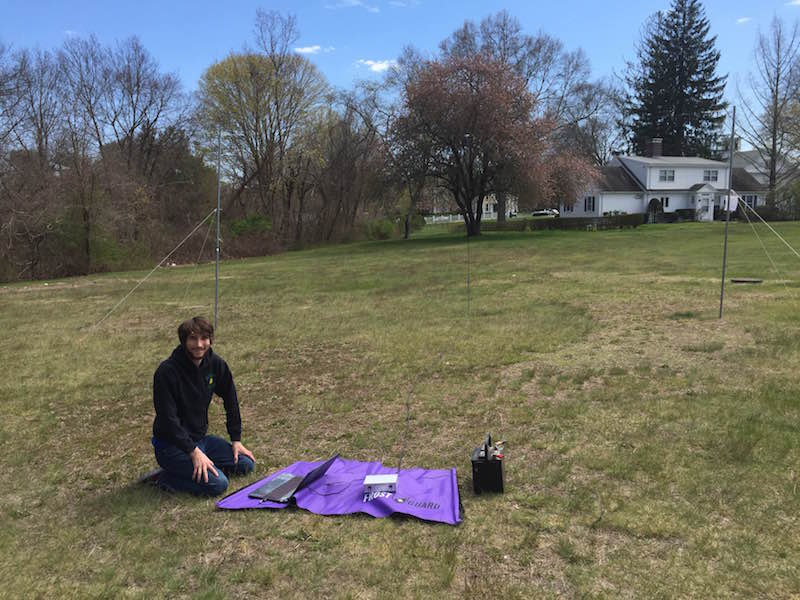

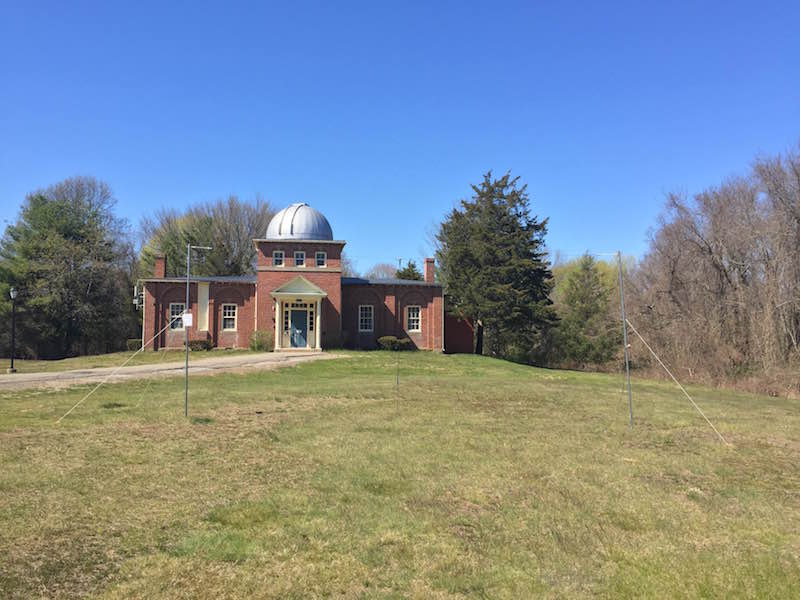
On August 21, 2017 the Great American Eclipse of 2017 will take place. The moon will pass directly between the Earth and the Sun and the shadow of the moon will follow a path across the continental United States from Oregon to South Carolina. There are many websites describing this amazing phenomenon, but one of the best for the technical details of the eclipse (what is happening when and where) may be found on the site maintained by “Mr. Eclipse”, Fred Espenak, a retired NASA astronomer (http://www.mreclipse.com/MrEclipse.html). There is much to be learned in perusing the many links on this site, but the links to the references for the 2017 eclipse on the home page are invaluable (Figure 1).

What does this have to do with Radio Jove? One of our favorite sources of radio emission is the Sun and we know that radio emission storms often occur in the corona of the Sun, the hot plasma above the visible surface (photosphere) of the Sun. Despite decades of study of the plasma interactions taking place in the corona causing powerful solar storms there is still much to be learned about how and where these interactions occur. Radio emission data are clues to the process and studies of the data taken during solar storms help determine the dynamics of storm generation and evolution.
The passage of the moon directly in front of the Sun from the Earth's viewpoint means that the Sun’s corona and photosphere will be occulted or cut off by the moon's path or transit and then reappear. If a solar radio storm were to occur during the time of the eclipse it is possible that the moon will gradually cover over the coronal source region and provide clues to the exact location of the source and how it evolves. Observers at different locations on the Earth would see the occultation happening at different times or perhaps not at all depending on their viewpoint.
We are asking Radio Jove observers in or near the U.S. to make observations on the days leading up to, during, and after the eclipse and to send your results to an archive for study. Even though you may not be located along the path of totality, where the moon completely covers the photosphere of the Sun, the moon will still occult parts of the corona for observers even fairly far away from the path of totality and it is possible that that part of the corona may have an active solar storm (Figure 2). Of course it is also possible that no storms will occur during the several hours of the moon’s transit across the Sun, but we can at least be ready in case there are events of interest.
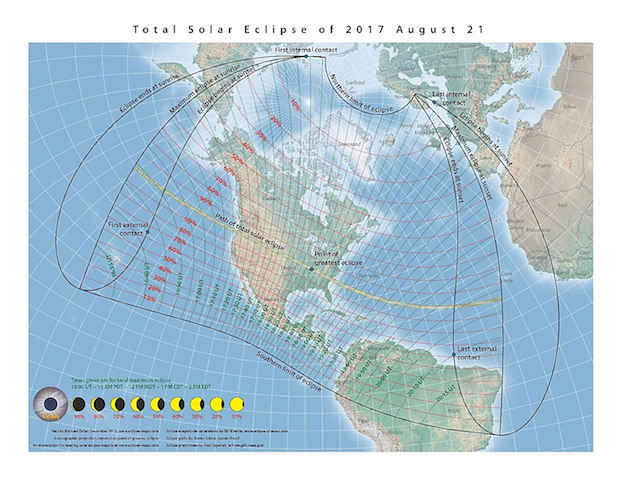
We would like to practice this coordinated observing of the Sun by designating a “warm-up” day of observations this year (2016) in preparation for the event of 2017. We have picked Friday, July 29th from 17:00-18:00 UT as the warm-up day and would like those who wish to participate in 2017 to practice with us in 2016. We will have several practice sessions in the upcoming months. If you are interested in doing this, just send us an email indicating your interest and a few details including:
Name
Address
Email Address
Description of Equipment
Location of Equipment
Anticipated Observation Start and Stop Times
We will add your email address to a special list of observers and keep you informed of the coming events via email. This new email address for eclipse observers will be announced soon from our general Radio Jove email distribution list. We will include you on a “radio map” of observers to be housed on the Radio Jove website.
For simplicity we will use the basic Radio Jove setup for solar eclipse observations (Figure 3). The equipment necessary is as follows:


We will provide further instructions in the coming weeks for those planning to participate. We appreciate your help in this citizen science project and we hope that we have success in our observations.
We would like to recognize a few Radio Jove observers who recently submitted data to the Radio Jove Data Archive and submitters who are returning after a long absence. Among the new observers are Mohammed Ajeel of Baghdad University, and from Middle Tennessee State University Josh Vaughn, John Jackson, and Jacques Beasley. We are also welcoming back Alfonso Castillo and Aleidi Nicolas from the Radio Observatory at the National Autonomous University of Mexico (UNAM).
Besides our new submitters I want to take this opportunity to thank all the submitters to the archive especially Jim Brown and Thomas Ashcraft for your dedication and hard work.
Thank you all and we are looking forward to many more observations. If you would also like to submit data please contact me at Leonard.N.Garcia@nasa.gov
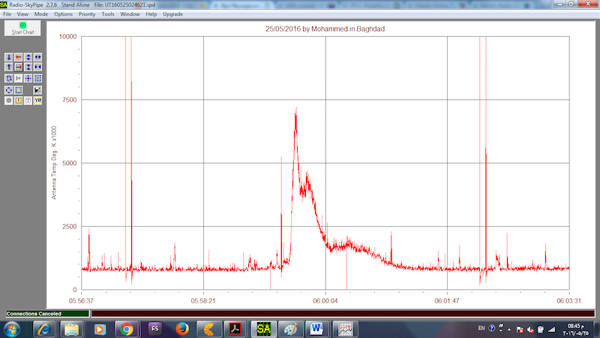
All radio astronomers must deal with radio interference. Some of us are kindly blessed with very little while others suffer mercilessly. To assist us in this fight the American Radio Relay League (ARRL) has a rogue's gallery of sound files from common sources of radio interference. Learning to identify the source of these problems may help you eradicate them.
The gallery can be found online at: http://www.arrl.org/sounds-of-rfi
Good luck!
The JOVE Bulletin is published twice a year. It is a free service of the Radio JOVE Project. We hope you will find it of value. Back issues are available on the Radio JOVE Project Web site, http://radiojove.gsfc.nasa.gov/
For assistance or information send inquiries to:
or
